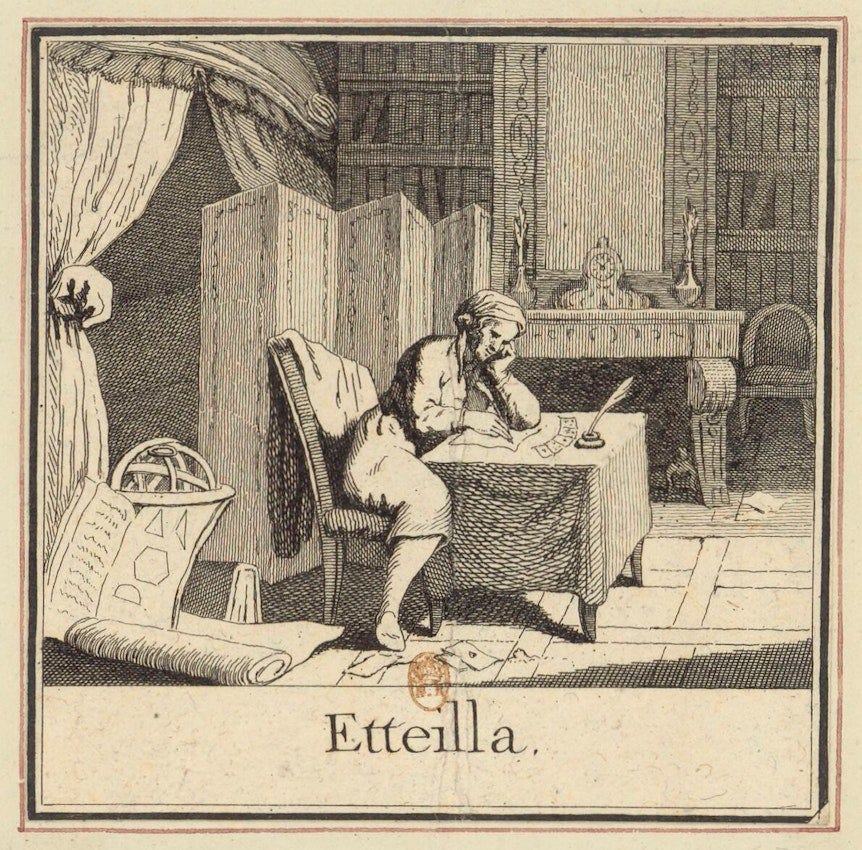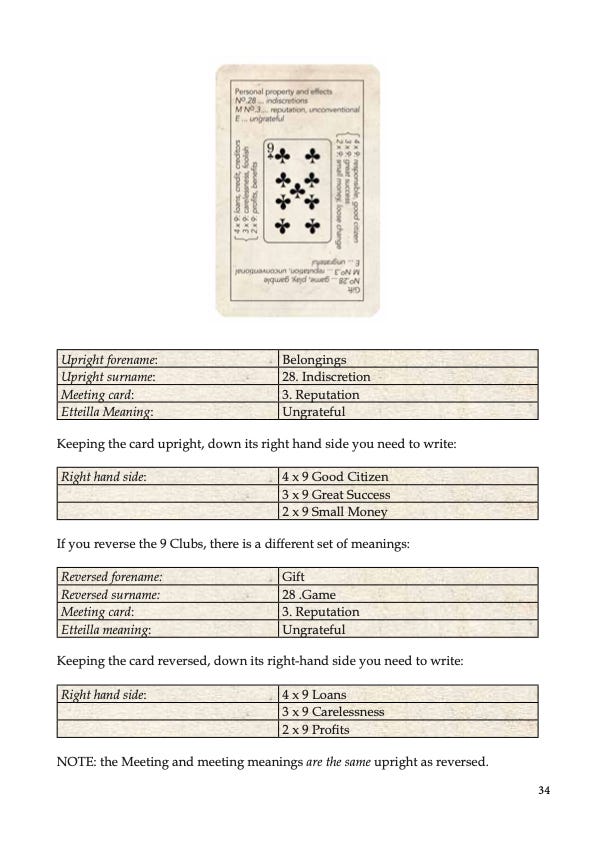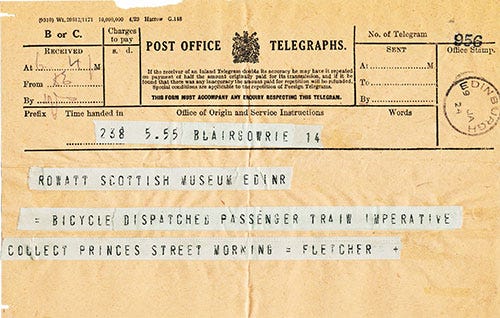In December 2025, the Original Petit Etteilla is coming: this book contains the fully- translated text of the 1773 edition of Etteilla’s ‘how to read cards’ book, translated by myself, with 33 cards designed by Rebecca Birrell, in one easy package. Here, I just unfold a little about the deck, about cartomancy and a view of how the system works.
THE ADVENT OF CARD DIVINATION
How did people begin to divine with cards? We know very little about this process before the late 18th century when both playing cards and tarot cards were used to play games or to gamble with, not to read on people’s questions. While there have probably been many people who practised cartomancy before this time, we have very little evidence of this, outside Italy.
In pre-Revolutionary France, there was a lot more stirring than just revolution. In 1770, a subversive little book was published entitled Etteilla, ou manière de se récréer avec un jeu de cartes, or A Way to Recreate Yourself with a Pack of Cards. Its author was Etteilla, a dealer in prints who was registered for tax-purposes as a tutor of algebra.
Etteilla was born Jean Baptiste Alliette (1 March 1738, in Paris, died 13 December 1791), in Paris, in the Palais Royal district - nowadays the exclusive 1st arrondissement - to a family of grocers and caterers. He was a humanist who was interested in ancient traditions, about which many people were beginning to speculate. Freemasonary was the esotericism of the day, seen as subversive to the established church. Like everyone who was not nobly born at this time, Eteilla had to hustle to make a living, and he perceived a good opening for his idea. As a dealer in prints, he had access to printing processes and knew just how popular were the different kinds of playing cards.
But because the French authorities took a dim view of occultists in general, and imposed draconian laws against public displays of divination or magic, he decided to reverse the order of his own surname and write his book under the pseudonym, ‘Etteilla.’ (pronounced Ett-EI’ya.) As he himself wrote, “whoever publicly reads as a cartomancer risks falling into the hands of the justices.” While he himself was never imprisoned, to our best knowledge, several cartomancers were, including the famous Mlle. Marie-Anne Lenormand, who was put into the notorious La Force prison between June-August in 1794, and later on in Belgium. It is for this same reason, in order to avoid any possible esoteric illegality that Etteilla describes his card-system as ‘an amusement’ or ‘pastime,’ something you do while you are waiting for you escort to arrive for the evening, or as a little pleasantry to try on a dull afternoon.
His little book proposed taking a commercially-available pack of playing cards, and throwing away all the cards numbered 2-6, to create a stripped deck of 32 cards, then to annotate them top, bottom, and sides with keywords from which to divine. He also suggested making a significator card or Carte Blanche (white card) to stand for the querent asking the divinatory question. (Readers of my book will not need to do this, as it comes with its own deck, but at least you have all the instructions if you should wish to recreate your own version from the original instructions.) This stripped playing card deck has become known since as The Petit Etteilla, to distinguish it from his later 78 card tarot or Grand Etteilla. Here is what it looked like:
As we see from the Etteilla or White Card, from this edition, the pack could be purchased at the Widow Gueffier’s at 61 rue Galande, in the 5th arrondissement. This address, near the Sorbonne today, has changed beyond recognition, but this is an early postcard of that premises, nearly 100 years later.
Despite the image of an overly-archetypal magician on the 1806 edition of his cards, in 1770, Etteilla was not promoting any esoteric doctrines or applying them to the Petit Etteilla, which remains a pragmatic system of card-divination that speaks about everyday events, rather than any supernatural ones. Nevertheless it is a unique system that shows us the very roots of cartomantic practice - the art of reading playing or other small cards for the purposes of divining.
We catch a mere glimpse of how Etteilla learned the. art of cartomancy. He mentions a certain “an old Piedmontese” called Alexis, whom he met at Lamballe in Brittany. Now, Piedmont is the region of Italy that immediately borders France, and it is quite possible that he learned some basic street-wise cartomancy which we know was in use since 1725 in Bologna. A quick check of Tarocchino Bolognese cartomancy shows that only four cards accord with the Etteilla’s own system, so this linkage remains possible but not conclusive.
Etteilla had a very good opinion of himself: a fact that oozes out of nearly every line of his book. He regards himself as the last word in divination and moreover writes, ‘my (Petit) Etteilla is a complete library of all that has been, is, and will be or could be written.’ Who are we to argue?
READING THE PETIT ETTEILLA
Etteilla’s book instructs readers to mark up their playing cards with keywords and shows them how to lay cards down. Here, the 9 Clubs shows how one card typically appears, with its meanings laid out beneath for easier viewing:
As we can see, the card has an upright and a reversed set of meanings, as well as some side meanings, which refer to an additional meaning that arises when you lay 2-4 cards of the same number in one line - so, four reversed Nines falling in the same line would give you ‘Profits’. The top keyword at either end of the card is called a ‘Forename,’and the meaning under it is a ‘Surname.’ When reading a line of cards, the reader attempts to read the forenames, and then the surnames sequentially to make a sentence.
The result of this kind of reading is not unlike the language once used in telegrams, where just a single word cost money, so you tried to collapse long sentences into terse statements: Ship arriving Dover 2nd May, 10pm. Send car. Eric.’ Reading Etteilla is a little like this - you have to add some propositions to create sense. Sometimes the following card doesn’t make sense so, following Etteilla’s instruction, you regard it as a mute card that has nothing to say.
In Petit Etteilla, you lay cards out from right to left: this is an older method of reading that seems strange to modern readers whose native language reads from left to right. But, like a lot of activities that reverse handedness, it turns on something different in the brain.
Here a querent asks why it is so hard for her to find acceptance in a group that she tries to be part of: reversed Q♦ + A♣ + Etteilla + reversed 7♠ + reversed 9♣ ←
Neither gifts nor friendship expected in this exclusive group. The financially well off members of this group will ensure that she finds herself forever on the outside, like an orphan in a big close family. Additionally, the Etteila White Card with A♣ shows that this group will become like a prison for the querent. The meeting cards at either end of the line, 3. 9♣ & 28. Q♦ indicate that the group find her far too unconventional for their narrow confines. The advice of the cards is that she is better off not persisting, and possibly finding some companions nearer to her own aims and social grouping.
Throughout his book, Etteilla reads serially for a certain lady whose adventures and hair-raising scrapes through 18th century France read like a chapter of Manon Lescaut by Antoine Françoise Prévost, with seductions and abductions, lying low in a convent tp avoid her creditors, and trying to fleece older rich men with the connivance of her female relative. This rackety young lady gives us lots of good examples of how to lay cards in many different ways.
The first thing that any reader will notice is how many cards are in Etteilla’s spreads: but the reading of cards in a cartomantic way is not long and drawn-out as it sometimes can be with tarot - it is speedy.While it is true that 18th century readings tend to use many cards and have several processes, these amply reveal the punchline or answer to the querent’s question.
There are also ways of using Etteilla techniques in shorter forms which are given in my book, which also clarifies Etteilla’s instructions for modern readers, amplifying how we can read the cards more efficiently.
The Original Petit Etteilla gives us many challenges, but it also rewards us with the treasures of cartomanctic reading skills that many readers have now lost. The mind-set of a pre-revolutionary Frenchman and his society, which about to change so radically, is often amusing or annoying, depending where you stand, but always engagingly pragmatic. If you want to understand how modern tarot reading has changed over the last three centuries, you will never find a better teacher than Etteilla, who stands for all modern card diviners today as the Father of Cartomancy.
From Etteilla’s little how-to book, myriads of small cartomantic card decks were spawned, with the whole of Europe joining in the run. He would undoubtedly have been very gratified to know this.


The Original Petit Etteilla by Caitlín Matthews & Rebecca Birrelll is available to pre-order in all the usual places, including
in USA:
Inner Traditions https://www.innertraditions.com/the-original-petit-etteilla
Simon & Schuster: https://www.simonandschuster.com/books/The-Original-Petit-Etteilla/Caitlin-Matthews/9798888503010
Simon & Schuster UK: https://www.simonandschuster.co.uk/books/The-Original-Petit-Etteilla/Caitlin-Matthews/9798888503010
Amazon: https://www.amazon.com/exec/obidos/ASIN/B0F1LRHWLQ?tag=simonsayscom
Barnes and Noble: https://www.barnesandnoble.com/w/the-original-petit-etteilla-caitl-n-matthews/1147150544;jsessionid=25B51F0A116A2FC30BFBE7F7968E915F.prodny_store02-atgap18?ean=9798888503010
Inner Traditions: https://www.innertraditions.com/the-original-petit-etteilla
Books A Million: https://www.booksamillion.com/p/9798888503010
https://bookshop.org/p/books/the-original-petit-etteilla-a-cartomancer-s-guide-to-divination-caitl-n-matthews/8447e3dc3101b8d5?ean=9798888503010&next=t&affiliate=1688
and in UK
https://www.simonandschuster.co.uk/books/The-Original-Petit-Etteilla/Caitlin-Matthews/9798888503010
https://www.waterstones.com/book/the-original-petit-etteilla/caitl-n-matthews/rebecca-birrell/9798888503010












